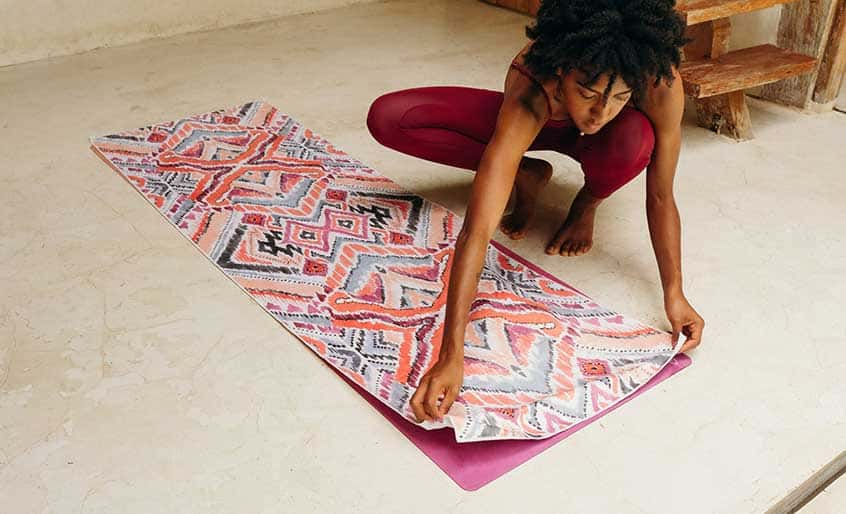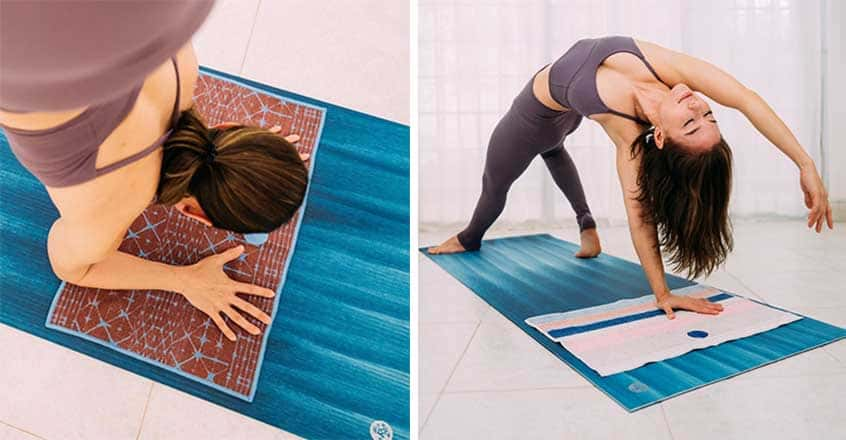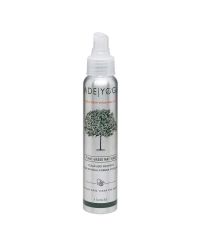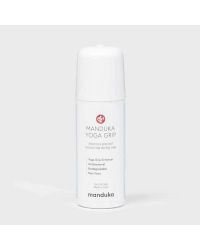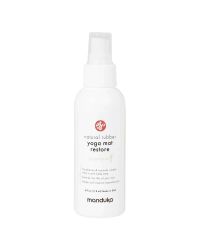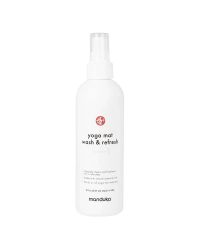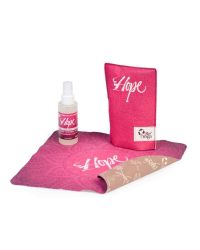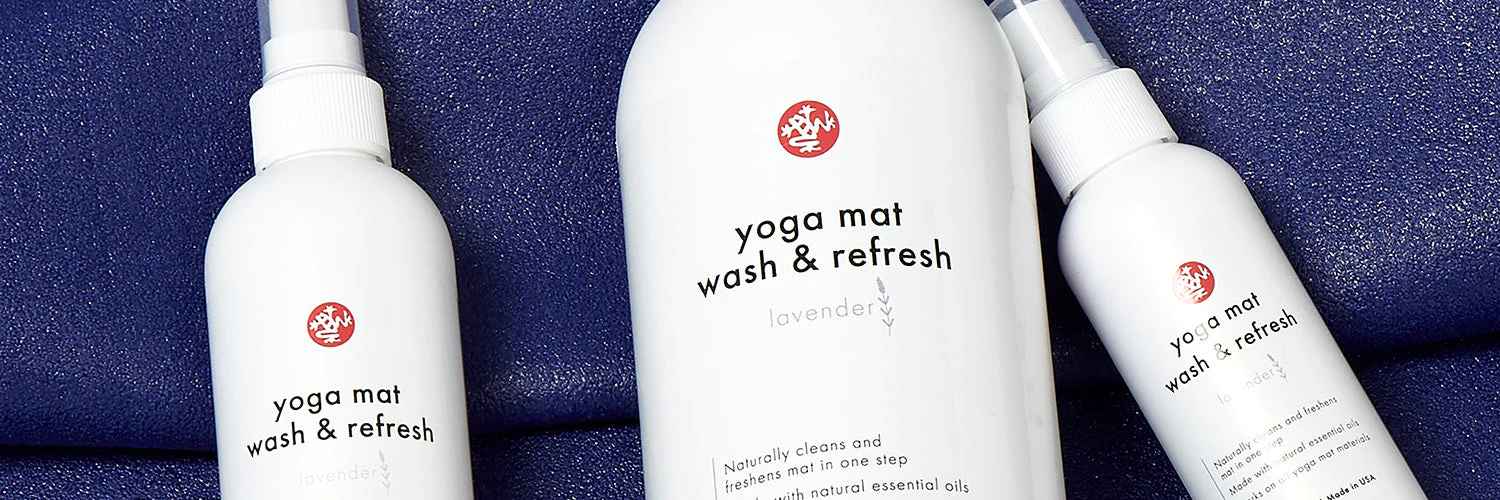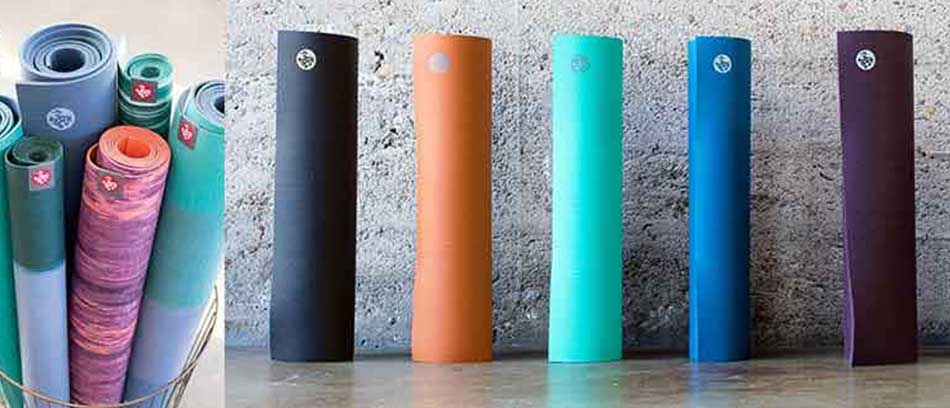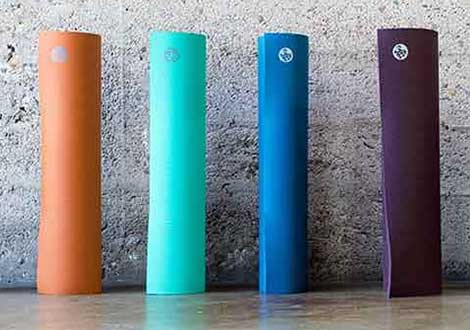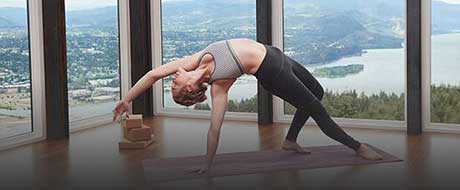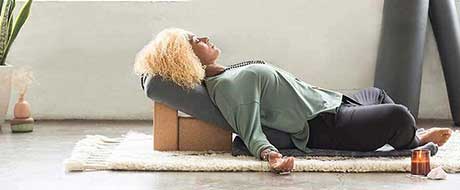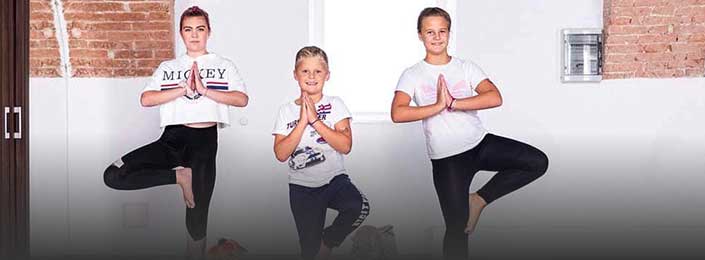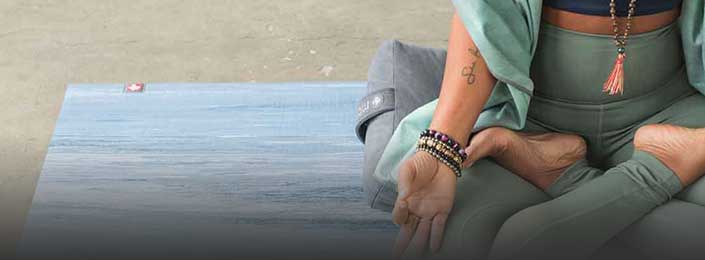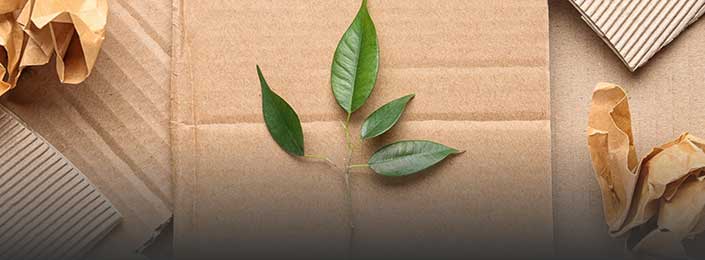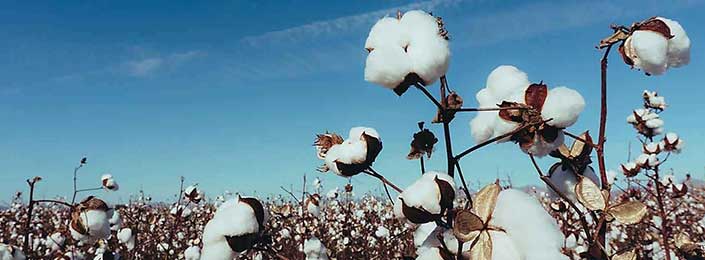We use cookies to make your experience better. To comply with the new e-Privacy directive, we need to ask for your consent to set the cookies. Learn more.
Cleaning yoga mats
How to clean and maintain a yoga mat?
Why is it important to take care of the "health" and cleanliness of our yoga mat?
On a yoga mat we lie, stand, squat... in short, our entire body and even our face is in contact with the yoga mat during exercise. Our personal yoga mat absorbs our sweat, skin dirt, particles of our skin, makeup, creams, and more and more liquids and micro particles. This applies to yoga mats with open cells. But yoga mats with a closed cell surface also need cleaning. It is true that they do not absorb dirt and liquids, but all this accumulates on the surface, which also needs to be cleaned.
An even worse case, problem: Do you ever wonder who has already sweated in front of you on the yoga mat in the yoga studio? And how many times has that studio yoga mat really been cleaned? Or what are the yoga mats like after exercising in nature?
So, the yoga mat is in contact with our skin. Just as a yoga mat absorbs all particles from the environment, our skin also works in a similar way. The dirt from the yoga mat touches our skin, which absorbs it all into our body.
Along with regular and correct cleaning, we also ensure a longer life of the yoga mat. And for better grip. Remove, restore and thoroughly clean the yoga mat. Proper care of your yoga mat is essential to maintaining the effectiveness, longevity and hygiene of your mat.
How to clean and maintain a yoga mat - table of contents
How to ensure a clean training environment?
Wash your hands and feet well before exercising
A small step that goes a long way to a cleaner yoga mat is washing your hands and feet before exercise. If this is not possible, you can use soft baby wipes and wipe your hands and feet with them. Exercise will be even more pleasant with clean hands and feet.
Uses of yoga towels
Practicing the use of a towel is also one of the steps to ensure a clean environment. Special yoga towels ensure that the towel does not slide on the mat. The top layer is usually a bit slippery, but the grip is still excellent in cases where we sweat a lot or the yoga towel can be lightly sprayed with water for excellent grip. In the case that we perform the asanas optimally, that we really use the muscles and that we are stable in the asanas, the yoga towel will then provide us with an excellent grip. In some exercises, bikram yoga, hot yoga and elsewhere, a yoga towel is even mandatory. Yoga towels can be washed normally in the washing machine. This is how we quickly and easily ensure a clean training environment.
Yoga towels are usually made of pleasant and super absorbent microfibre. Skin contact is gentle. Such a towel has a very small volume and can always be carried in a bag. At the same time, it can also be used as a travel towel, beach towel, blanket,... in short, a yoga towel is an extremely useful piece of equipment.
Special among towels is Manduka's Yogitoes® yoga towel with the patented Skidless® Technology system of silicone cells on the underside. This additionally ensures that the towel always stays in place. And a similar ReYoga Grippy Boo yoga towel, which is also thicker and is kind of a hybrid between a towel and a yoga mat.
For yoga towels, you can choose from larger dimensions that cover the entire yoga mat. Or among the small "hand towels", which are used to wipe our sweaty face and hands on the spot, or we can place it at the beginning or end of the mat, under our hands or legs.
Cleaning and caring for a yoga mat!
There are many varieties of yoga mats on the market. Natural rubber, cotton, TPE, microfiber, PU, cork, other artificial and natural materials... That's why there are more yoga mat cleaners. Because the flexibility and function of natural rubber, rubber, is maintained differently than some artificial, less demanding material. We usually do not wash the yoga mat in the washing machine, soak it in the bathtub, or shower it. Of course, with certain types of yoga mats this is allowed and this is usually specifically highlighted.
We pointed out at the beginning that the method of cleaning yoga mats depends on the type of yoga mat. We distinguish closed-cell yoga mats, which do not absorb liquids, and open cell yoga mats that absorb fluids.
There are several closed-cell yoga mats that make cleaning easier. These are usually mats made of TPE material and other synthetic materials. An exception is Manduka's eKo series, which is made of rubber (natural rubber), but has a closed-cell top layer - thanks to a special surface treatment system. These are eKo Lite 4mm, eKo Superlite 1.5mm, eKo 5mm, and versions in the extended, LONG version.
Open cell yoga mats are usually mats made of natural materials - rubber (natural rubber) and cork. And mats with PU (polyurethane) surface and Microfibre mats.
It is important to follow the instructions for each cleaning agent when cleaning. The procedures are not always the same. It is important for every cleaning, regardless of the cleaning agent used to clean the yoga mat:
- never roll up a wet, damp mat
- we always wait until the mat is completely dry
- roll the mat with the outer side facing out (when the mat is rolled, you can see the surface of the mat on which to practice)
- do not dry the mat on a radiator or any other direct heat source
- do not dry the mat directly in the sun or we also do not expose it to direct sunlight (UV rays can damage the material)
- do not rub the mat with rough brushes, only with soft, gentle cloths
- rubber mats, natural rubber may have a slight rubber smell (the smell disappears over time)
- rubber mats, natural rubber can "oxidize" over time and get colored spots on the surface
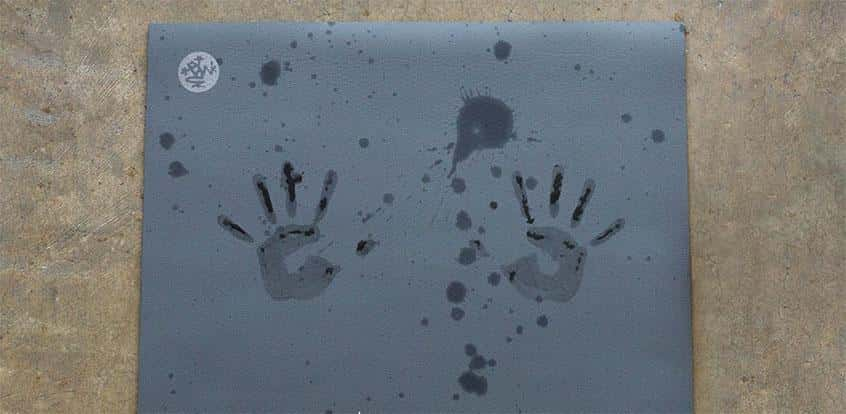
Frequently asked questions about cleaning a yoga mat
Why is it not recommended to use moisturizing or disinfecting wipes to clean the yoga mat?
When cleaning a yoga mat with yoga mat cleaners, we usually spray the yoga mat with the cleaner over the entire surface. So that the mat is visibly wet. Let the cleaner work for 4-5 minutes or as much as in the instructions on the cleaner. This is difficult to achieve with moisturizing wipes.
Usually, wet wipes contain active disinfectant ingredients, as this is what kills viruses. These ingredients can adversely affect the material of the yoga mat. In addition, the components of the moisturizing wipes remain on the surface of the yoga mat, and often our skin is so sensitive that long-term skin contact with such substances causes allergic reactions on the skin.
Why don't we recommend homemade yoga mat cleaners?
We used to prepare our own cleaners at home to clean yoga mats. We usually put a little essential oil in the water to get a pleasant smell and at the same time an "imaginary" disinfectant. Or we used water and dishwashing detergent. We even used a mixture of water and vinegar.
The ingredients in cleaners from renowned manufacturers are almost identical. However, their cleanser is completely different.
As we know water and oil do not mix. So how do cleansers that contain essential oils combine the two ingredients into one? At Manduka, essential oil and a biologically based "solvent" are added to the purified water. Then the mixture of all three ingredients is mixed in a "mixer" (an industrial mixer has approx. 1700 revolutions per minute, and a home mixer only approx. 280 revolutions per minute). This ensures that the cleaner is dispersed on the mat through the packaging sprayer in the right balance of water and essential oil, as every drop contains all the components of the cleaner.
Another very important thing is water! Manufacturers use fully purified water to make cleaners. Thus, the water has no impurities (minerals). Even distilled water can contain microscopic organic matter. All these impurities in the water can damage the yoga mat or even cause mold to form. Some manufacturers use the cheap process of using a biocide to destroy the organic matter in the water. And at Manduka and ReYoga they prefer to purify the water to remove minerals and microscopic organic matter. Although this process is more expensive, it means that no chemicals are added to the cleaner.
Essential oils in cleaners? Will the yoga mat slide?
No. If you were to apply the essential oil directly to the surface of the yoga mat, then the yoga mat would become really slippery. Using the cleaner, spray the cleaner on the surface of the yoga mat, let it work for a few minutes (as much as recommended in the instructions) and then wipe the yoga mat with a soft cloth. In this way, most of the cleaner is removed. At the same time, the mixture of ingredients in the cleaner is so strongly "mixed" that the cleaner is sprayed on the yoga mat very evenly and thus there is no direct application of aesthetic oil. Even if there is some cleaner left on the yoga mat, it is very unlikely that it will affect the grip.
Are all yoga mat cleaners also disinfectant cleaners?
No. In fact, disinfectant cleaners for yoga mats are more of a rarity. Disinfectant cleaners are not used on open-cell yoga mats. Such mats absorb liquids. And once the mat absorbed the disinfectant, it would be nearly impossible to wash and remove it from the core. This could lead to a shorter life of the yoga mat and damage to the material. In our offer you can find two disinfectant cleaners: Botanical Cleanser from Manduka and Karma Cleaner from ReYoga.
How often should we clean the yoga mat?
Great question! A slightly more complicated answer. Deep cleaning of the yoga mat should only be used occasionally. That's when we really notice that our yoga mat has been exposed to dirt and sweat for a long period of time. If we practice at home, deep cleansing should be used rarely. Of course, with yoga mats in the studio, you should do this quite often. It is recommended to regularly, quickly "refresh" the surface of the yoga mat after each exercise. Yoga Mat Wash & Refresh from Manduka or set for cleaning the yoga mat from ReYoga and ReYoga refill.
Can the yoga mat cleaner be used to clean the yoga mat?
To clean the yoga mat, you can use the "classic" cleaners for yoga mats to keep the mats nice smells fresh. From time to time, it is good to disinfect the yoga mat. You can easily do this with Botanical Cleanser from Manduka or Karma Cleaners from ReYoga.
Cleaning and maintenance of yoga mats
What could be worse, when we want to practice yoga, we spread out a yoga mat in front of us...and it is full of stains and the smell of old sweat.
When yoga mats were tested in a laboratory in the USA years ago, what a yoga mat "contains", the results were astounding. The yoga mat of a woman who admitted that she didn't clean the mat regularly and very often "contained" over 12 million bacteria.
You can imagine that studio yoga mats are probably not only full of bacteria, microbes, but also an excellent environment for the spread of fungi, acne or even some skin diseases.
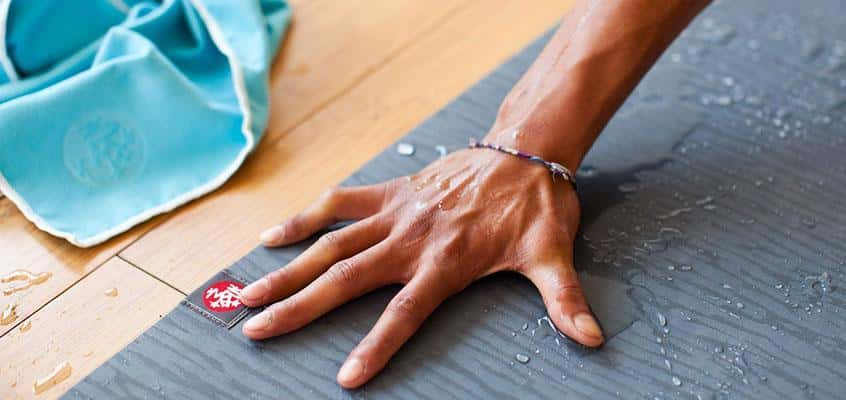
Cleaning a yoga mat with a closed-cell surface!
Cleaning closed cell yoga mats is quite easy. Perhaps, first of all, let's say which mats we place in this category: these are mats made of TPE material and other synthetic materials. The exception in this group is the Manduka eKo series, which is made of natural rubber, but due to the special treatment of the top layer, it has a closed cell surface.
We include yoga mats in this category:
- Manduka Pro Series (Pro, Pro Lite, Pro Travel and all versions of extended Pro mats, Long)
- Manduka X mat
- Manduka welcOMe / Begin
- ReYoga Soft yoga mat and Light yoga mat
- Yoga Design Lab Flow yoga mat
- Manduka eKo series (eKo Lite, eKo Superlite, eKo 5mm and all versions of extended eKo mats, Long)
- Lotuscrafts Mudra and Mudra XL yoga mats
- Gaiam yoga mats
All of the above yoga mats are taken care of after every workout with Yoga Mat Wash & Refresh cleaners or with set for cleaning the yoga mat from ReYoga and ReYoga refill. Spray the surface of the yoga mat with the cleaner and then wipe it with a soft, dry cloth. Then wait for the mat to dry well and that's it. With this step, we ensure that the mat is clean and fresh after each workout, completely ready for a new workout. Regular cleaning avoids strong "clogging" of the surface of the yoga mat. The mat is fragrant and clean, and the grip of the mat is as it should be every time.
If our mat is more dirty, we can "deepen" the above process. Spray the mat more vigorously with Yoga Mat Wash & Refresh with cleaners or with set for cleaning the yoga mat from ReYoga and ReYoga Refill so that it is visibly wet. Wait 1-2 min. Then wipe with a dry and soft cloth and rub any stains a little.
Yoga mat Wash & Refresh cleaners are available in two scents: lavender and lemongrass.
For stubborn stains: spray the cleaner, apply directly to the stain and leave for a few seconds. Then gently wipe with a damp cloth. We wait for it to dry!
ReYoga Reclean cleaner is extremely convenient, as it is packaged in a small spray bottle, a small microfiber cloth is included, and both together in a cute zippered bag. There are several scents available: Happiness, Hope, Freedom and Peace. But when the cleaner is used up, we can only buy the Cleaner Refill, with which we fill a small spray for on the go.
For even more thorough cleaning, use the Botanical Cleanser, which is also a disinfectant . For smaller stains, the cleaner can be sprayed on the stain and wiped with a soft cloth. For a more thorough cleaning, spray the cleaner on the mat so that the mat is visibly wet. Leave the cleaner on for 10 minutes, then wipe with a soft cloth. Leave the mat to dry. No rinsing required.
The disinfectant cleaner from ReYoga Karma works similarly. Apply the cleaner to a cloth and wipe the yoga mat. The cleaner contains alcohol, which evaporates, leaving behind a thyme scent. Do not apply the cleaner directly to the yoga mat. A soft microfiber cloth is included.
The eKo series, which is made of natural rubber, is recommended to be cleaned from time to time with a special cleaner designed specifically for rubber. This is Natural Rubber Yoga Mat Restore , which ensures a longer life and flexibility of the rubber. Spray the cleaner liberally over the entire surface of the mat. Leave on for 5 min. Then wipe with a clean, soft cloth. Clean with this cleaner no more than once a month. The cleaner is not intended for everyday cleaning.
Cleaning a yoga mat with an open-cell surface!
Cleaning yoga mats with open cells is more challenging. Perhaps, first of all, let's say which mats are included in this category: these are mats made of natural materials (rubber, cork), mats with a PU (polyurethane) surface and mats with a microfiber surface.
We include yoga mats in this category:
- Lotuscrafts cork yoga mat
- Yoga Design Lab cork yoga mat
- Manduka series GRP (GRP, GRP Lite, GRP Adabt)
- ReYoga Grow yoga mat and Steady yoga mat
- ReYoga Ride yoga mat
- Liforme
- Yoga Design Lab Infinity 5.0mm
- Manduka eQua Round
- Yoga Design Lab Travel yoga mat
- Yoga Design Lab Combo yoga mat
- Yoga Design Lab Kids Combo yoga mat
- JadeYoga yoga mats from natural rubber
For rubber mats (ReYoga Grow, Steady, Ride and JadeYoga mats) we recommend natural rubber cleaner from JadeYoga, which makes the rubber last longer and more flexible. Spray the cleaner liberally over the entire surface. Spray the mat with Jade Mat Wash cleaner. Then wipe it off with a clean, soft towel. Wait for it to dry (leave the mat unfolded and away from sunlight for a few minutes). Or we can use Natural Rubber Yoga Mat Restore, which also ensures a longer life and flexibility of the rubber. Spray the cleaner liberally over the entire surface of the mat. Leave on for 5 min. Then wipe with a clean, soft cloth. Clean with this cleaner no more than once a month. The cleaner is not intended for everyday cleaning.
For yoga mats covered with PU such as the Yoga Design Lab Infinity mat and all Liforme yoga mats, we recommend the cleaner Liforme Cleaner, which is made especially for yoga mats with PU surface. (Unfortunately, Liforme items cannot be sold online, but it is available in our store in Kranj. We can also send it to you, so call or send a message and we'll talk.)
Apply Liforme Cleaner to a soft sponge or microfibre cloth and use it to clean the yoga mat. You can also apply the cleaner directly to the yoga mat, wait 30 seconds and then clean the mat with a soft sponge. Wait for the mat to dry completely.

All the other yoga mats listed above are taken care of after every exercise with Yoga Mat Wash & Refresh with cleaners or with set for cleaning the yoga mat from ReYoga and ReYoga refill. Spray the surface of the yoga mat with the cleaner and then wipe it with a soft, dry cloth. We wait for the mat to dry well and that's it. With this step, we ensure that the mat is clean and fresh after each workout, completely ready for a new workout. Regular cleaning avoids strong "clogging" of the surface of the yoga mat. The mat is fragrant and clean, and the grip of the mat is as it should be every time.
If our mat is more dirty, we can "deepen" the above process. Spray the mat more vigorously with Yoga Mat Wash & Refresh or set for cleaning the yoga mat from ReYoga and refill ReYoga cleaner so that it is visibly wet. Wait 1-2 min. Then wipe with a dry and soft cloth and rub any stains a little.
Yoga mat Wash & Refresh cleaners are available in two scents: lavender and lemongrass. And in two different sizes of packaging: a larger one 227 ml and a smaller one, convenient for travel, for the bag 118 ml.
For stubborn stains: spray the cleaner, apply directly to the stain and leave for a few seconds. Then gently wipe with a damp cloth. Wait for it to dry!
ReYoga Reclean cleaner is extremely convenient, as it is packaged in a small spray bottle, a small microfiber cloth is included, and both together in a cute zippered bag. There are several scents available: Happiness, Hope, Freedom and Peace. But when the cleaner is used up, we can only buy the Cleaner Refill, with which we fill a small spray for on the go.
For "medium" fast cleaning you can also use "foam". Spray the foam onto a soft, gentle sponge or cloth. Use it to wipe stains on the yoga mat or the entire surface of the yoga mat. Then wash the yoga mat with fresh water using a cloth or soft sponge. Wait for the mat to dry thoroughly before rolling it up.
For this more thorough cleaning / deep cleaning of open-cell yoga mats, use the Deep Cleanser. Add one cap (approx. 10ml) of the cleaner to 3.5 liters of water. Make a bath. Immerse the yoga mat in the prepared bath for 5-10 min. Turn it over several times. Then rinse the yoga mat with fresh water. Wait for the mat to dry thoroughly before rolling it up. Let the yoga mat dry for at least 24 hours.
Yoga mat with microfiber surface:
Yoga Design Lab yoga mats, which have a microfiber surface (Travel, Combo, Commuter, Kids Combo) can also be washed in the washing machine. Otherwise, we recommend that you use it as rarely as possible, because washing in the washing machine is a longer process and can affect the life of the yoga mat. If we are going to wash in the washing machine from time to time - do not use a centrifuge, softeners, bleaches or other aggressive substances. Wash at a low temperature on a program for the most delicate textiles. Dry the mat thoroughly after each wash.
Yoga mats made of cork:
Cork yoga mats are also special. You can always roll a cork yoga mat from the outside to the inside (so that the cork is on the outside) - this prevents the cork from breaking and prevents the yoga mat from bending. Cleaning – cork is a natural material and has antibacterial and antimicrobial properties. In case of very frequent use, regular cleaning (once a week) is recommended. Clean the mat with cold water and a mild detergent, e.g. Yoga Mat Wash & Refresh, or Reyoga Reclean. Then it must be dried well.
Cork can darken in individual parts or the mat gets darker stains. It is quite possible that such dark spots will not be able to be removed. This is completely natural, as our skin releases various substances to the surface through sweating, which can stain natural materials. Creams, oils and lotions used on the skin can also cause the mat to become discolored. But the function of the mat remains unchanged!
Salt "bath"? Yes, some yoga mats need it!
Manduka Pro series (Pro, Pro Lite,Pro Travel and all versions of extended Pro mats, Long) need just such care. This series of yoga mats has a lifetime guarantee, the material is extremely durable. The new yoga mat from the Pro series has a kind of "filter / film" on the top surface. That is why the mat can slide in the beginning, during the first yoga practices. The solution is very simple.
Watch the video below or follow the steps:
- Spread the Manduka Pro mat on the floor with the top side facing forward.
- Sprinkle sea salt on the mat. Fine ground.
- Let the salt work for 24 hours.
- Then wipe the salt thoroughly with a wet cloth.
- After the mat has been thoroughly cleaned of salt, dry it thoroughly.
- Practice ON! Let the practice begin!
